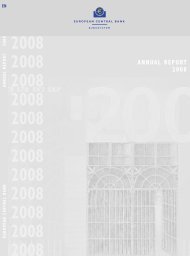Reserve Bank of Australia Annual Report 2011
Reserve Bank of Australia Annual Report 2011
Reserve Bank of Australia Annual Report 2011
Create successful ePaper yourself
Turn your PDF publications into a flip-book with our unique Google optimized e-Paper software.
4<br />
3<br />
2<br />
1<br />
0<br />
and Securency International Pty Ltd – companies that are respectively fully owned and partly owned by the<br />
<strong>Reserve</strong> <strong>Bank</strong> – is the responsibility <strong>of</strong> the Boards <strong>of</strong> the companies. The risks inherent in the ownership <strong>of</strong> the<br />
companies are managed by the <strong>Bank</strong>.<br />
Portfolio Risks<br />
The vast majority <strong>of</strong> the <strong>Reserve</strong> <strong>Bank</strong>’s assets comprise domestic and foreign currency-denominated financial<br />
instruments that are used to help meet its policy objectives. These assets expose the balance sheet to a number<br />
<strong>of</strong> financial risks, <strong>of</strong> which the most important are exchange rate, interest rate and credit risks. The responsibility<br />
for managing these risks rests with the Financial Markets Group. However, the RMU is responsible for monitoring<br />
these risks and ensuring compliance with the control framework.<br />
The <strong>Bank</strong> cannot eliminate its portfolio risks as this would interfere with its ability to implement its policy<br />
objectives. The risks are instead managed to a level consistent with the <strong>Reserve</strong> <strong>Bank</strong>’s objectives through a<br />
number <strong>of</strong> controls, which are discussed below. In addition, the Assistant Governor (Financial Markets), the<br />
Head <strong>of</strong> Risk Management and other senior staff are provided with daily reports on limits compliance, portfolio<br />
risks and performance.<br />
Exchange rate risk<br />
The <strong>Reserve</strong> <strong>Bank</strong> invests in foreign currency-denominated assets as holder <strong>of</strong> <strong>Australia</strong>’s <strong>of</strong>ficial foreign<br />
currency reserves. This exposes the <strong>Bank</strong>’s balance sheet to fluctuations in exchange rates, commonly referred<br />
to as exchange rate risk.<br />
Given its policy role, the <strong>Reserve</strong> <strong>Bank</strong> cannot eliminate this exposure. Rather, the <strong>Bank</strong> mitigates its exchange<br />
rate risk by diversifying its foreign-currency assets across four highly liquid currencies. The allocation was<br />
changed over the course <strong>of</strong> 2010/11 to include assets denominated in Canadian dollars, taking the portfolio<br />
Exchange Rate Risk on RBA<br />
Foreign Currency Portfolio<br />
For a 10 per cent appreciation <strong>of</strong> exchange rates, as at 30 June<br />
A$b<br />
A$b<br />
1995<br />
Source: RBA<br />
1999<br />
Interest rate risk<br />
2003<br />
2007<br />
4<br />
3<br />
2<br />
1<br />
0<br />
<strong>2011</strong><br />
composition to 45 per cent in US dollars, 45 per cent<br />
in euros, 5 per cent in Japanese yen and 5 per cent in<br />
Canadian dollars (see chapter on ‘Operations in<br />
Financial Markets’). The allocation to Canadian dollars<br />
was effected gradually to avoid disrupting markets.<br />
The portfolio is rebalanced daily taking into account<br />
changes in market rates or transactions.<br />
The exchange rate risk on the portfolio declined over<br />
the year as the value <strong>of</strong> the foreign currency reserves<br />
portfolio fell, in <strong>Australia</strong>n dollar terms, owing to the<br />
appreciation in the <strong>Australia</strong>n dollar exchange rate.<br />
The portfolio was unchanged when measured in<br />
foreign currency terms. At the current level <strong>of</strong><br />
reserves, the potential loss from a 10 per cent<br />
appreciation in the <strong>Australia</strong>n dollar would result in<br />
valuation losses <strong>of</strong> around $3.2 billion.<br />
The <strong>Reserve</strong> <strong>Bank</strong>’s financial assets largely comprise domestic and foreign fixed-income securities. The value <strong>of</strong><br />
these assets is affected by movements in interest rates as the payment stream <strong>of</strong> these securities is fixed. In<br />
general, longer-dated securities are more sensitive to movements in interest rates than shorter maturity<br />
instruments.<br />
54 <strong>Reserve</strong> bank <strong>of</strong> <strong>Australia</strong>





![KNOW YOUR NEW GIBRALTAR BANKNOTES - [Home] bThe/b](https://img.yumpu.com/50890985/1/184x260/know-your-new-gibraltar-banknotes-home-bthe-b.jpg?quality=85)
![PAPUA NEW GUINEA - [Home] - Polymer Bank Notes of the World](https://img.yumpu.com/49758743/1/190x143/papua-new-guinea-home-polymer-bank-notes-of-the-world.jpg?quality=85)










